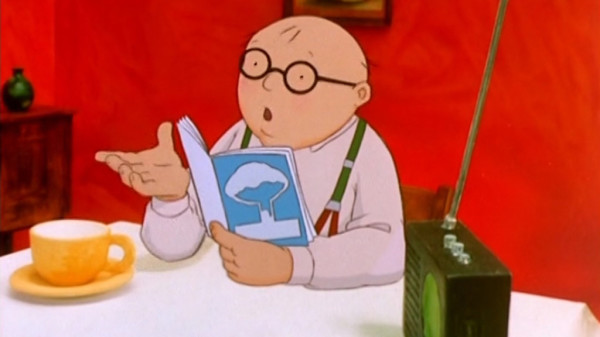
In honour of the New Empress Magazine Adaptations Special, here is a discussion of an adaptation which holds a special place in my heart and mind; Raymond Briggs’ When the Wind Blows. There were plenty of films that scared me as a youngster; like many, I wailed over Hazel being stalked by the black rabbit in Watership Down (1978) and sniffed the tears/snot back as Bambi (1942) dashed about trying to locate his slain mama in the snowy forest of Disney but When the Wind Blows (1986) is surely the scariest animated film of them all.
In 1982 Raymond Briggs, better known for The Snowman (film of which came out in 1982) and probably Father Christmas (voiced by the jolly, dear departed Mel Smith in 1991), decided to write When the Wind Blows for an older [or more cynical] audience, covering a topic that no one must have thought that he might ever tackle: Nuclear War. When there was discussion of turning When the Wind Blows into a film, director Jimmy Murakami’s name was apparently the first to come to mind, a prudent appointment given the eventual result.
The 48 page graphic novel features a short passage of time in the lives of Jim and Hilda, a couple of everyday folk, a retired pair who deal the best they can with the sudden onslaught of war, a war that no one thought would ever happen between ‘the West’ and Russia. Jim thinks they can wait out the dropping of the bomb on London, the two of them having retreated to leafy Sussex post-retirement. After all, he has some very informative government and county council leaflets on how a citizens can protect themselves from the nuclear blast and fallout, not to mention his and Hilda’s experience of WW2. What is acknowledged by neither government nor citizen is that this war has nothing in common with those that have come before. In fact, Jim and Hilda find themselves reminisicing about bombs that you could simply hide from in an Anderson shelter or Underground station and having daydreams about what they’d do if a Russian soldier suddenly made his way up the garden path towards the house, furry hat, gun sporting a bayonet, thick moustache and all. When the unthinkable happens the viewer experiences an all-encompassing despair and sadness as Jim and Hilda struggle along in a post-apocalyptic haze of desperately clung-to routines and reassurances that it would all be over soon.
The humour of the text and the warmth of the animation that Briggs is well known for (in both book and film) manages, for a time, to cushion the absolutely devastating impact of what is happening to this couple, who are so recognisable they might just be your next door neighbours or your friend’s mum and dad. Raymond Briggs took his inspiration for them from his mum and dad; his parents being the basis for many of the characters he has drawn. The focus on their pain, the human cost of war, is excruciating but necessary.
The darkness, the utterly bleak nature of what is happening to Jim and Hilda, voiced by John Mills and Peggy Ashcroft, is very hard to take. The film deals with the impact on the surrounding areas in a way that the book does not; showing the impact of the blast on nearby towns. The way the book depicts that the bomb has fallen is in the melting away of the pictures from the page, the illustrations only returning as the light and heat of the bomb has faded. In the film we are shown the impact of the blast on their house in great detail; we do not know how long it took Jim and Hilda to come round after the blast but are given the impression that it must have been some time, the structural damage not limited to the four walls and roof surrounding them. The animation knitted in with shots of a model of their house gifts an added realism to the situation.
I watched the film probably no more than once or twice as a kid but it is forever etched on my soul. The pain and anguish of watching these harmless, lovable characters fade away is as much as a deterrent as anyone might need; the deterrent, that is, to thinking that nuclear weapons or indeed war in general could ever be the answer to anything. Jim recounts the reasoning for wearing white clothes, after reading that instruction in one of his informative leaflets, was that after the bomb was dropped on Hiroshima at the end of WW2 those wearing stripes on their clothing had the stripes burned on to their skin. The casual mention of that endlessly horrifying event has the impact of a punch to the stomach, reminding us that this isn’t just a story, this sequence of events actually happened to people in the 20th century, inflicted upon one nation by another.
When the Wind Blows is essential reading and/or viewing, whether child or adult. If we can watch The blinking Snowman every bloody Christmas, then each of us surely has time to watch the ultimate anti-war, anti-bomb parable at least once in our lives.













{ 0 comments… add one now }